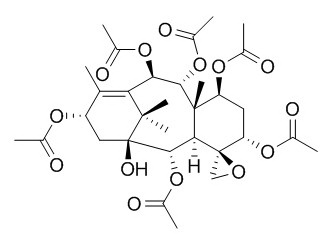1-Hydroxybaccatin I
1beta-Hydroxybaccatin I possesses significant antinociceptive activity against p-
benzoquinone-induced abdominal contractions.
Inquire / Order:
manager@chemfaces.com
Technical Inquiries:
service@chemfaces.com
Tel:
+86-27-84237783
Fax:
+86-27-84254680
Address:
1 Building, No. 83, CheCheng Rd., Wuhan Economic and Technological Development Zone, Wuhan, Hubei 430056, PRC
Providing storage is as stated on the product vial and the vial is kept tightly sealed, the product can be stored for up to
24 months(2-8C).
Wherever possible, you should prepare and use solutions on the same day. However, if you need to make up stock solutions in advance, we recommend that you store the solution as aliquots in tightly sealed vials at -20C. Generally, these will be useable for up to two weeks. Before use, and prior to opening the vial we recommend that you allow your product to equilibrate to room temperature for at least 1 hour.
Need more advice on solubility, usage and handling? Please email to: service@chemfaces.com
The packaging of the product may have turned upside down during transportation, resulting in the natural compounds adhering to the neck or cap of the vial. take the vial out of its packaging and gently shake to let the compounds fall to the bottom of the vial. for liquid products, centrifuge at 200-500 RPM to gather the liquid at the bottom of the vial. try to avoid loss or contamination during handling.
Mediators Inflamm. 2016, 2016:6189590
Front Pharmacol.2021, 12:607403.
Sci Rep.2023, 13(1):7475.
Environ Toxicol.2022, 37(3):514-526.
Sci Adv.2018, 4(10)
Biomolecules.2020, 10(6):925.
Molecules.2023, 28(8):3503.
J Vet Sci.2020, 21(3):e39.
J Anal Methods Chem.2022, 2022:2229500.
Nat Commun.2023, 14(1):8142.
Related and Featured Products
J Nat Med. 2013 Jul;67(3):512-8.
Development of an indirect competitive enzyme-linked immunosorbent assay (icELISA) using highly specific monoclonal antibody against paclitaxel.[Pubmed:
23007175]
Paclitaxel, the major active component of the yew tree, is used as an important anti-cancer agent.
METHODS AND RESULTS:
To obtain the monoclonal antibody (MAb) against paclitaxel for paclitaxel determination using immunoassay, 7-xylosyltaxol was conjugated to the carrier protein bovine serum albumin (BSA) to construct the immunogen, and the ratio of hapten in XylTax-BSA conjugate was determined by matrix-assisted laser desorption/ionization time-of-flight mass spectrometry. After immunization of mice with this conjugate, hybridomas secreting MAbs against paclitaxel were obtained by fusing the splenocytes with the mouse myeloma cell line SP2/0. After hybridoma screening, the anti-paclitaxel MAb 3A3 was obtained, which showed a relatively high specificity to paclitaxel (cross-reactivities against other naturally occurred taxanes: 7-xylosyltaxol, 31.8%; cephalomannine, 6.17%; baccatin III, 10-deacetyl-baccatin III, 1-Hydroxybaccatin I, 13-acetyl-9-dihydrobaccatin III and 1-acetoxyl-5-deacetyl-baccatin I, <0.11%). Using the MAb 3A3, we established an indirect competitive enzyme-linked immunosorbent assay (icELISA) for paclitaxel determination with a detection range of 0.098-312.5 μg ml(-1). Determination of paclitaxel contents in various yew tree samples with this icELISA resulted in recovery rates ranging from 92 to 94.8%, and intra- and inter-assay variations of 3.6 and 4.7%, respectively.
CONCLUSIONS:
This icELISA provides a valuable method of paclitaxel determination for various purposes.
J Ethnopharmacol. 2003 Dec;89(2-3):265-70.
Anti-inflammatory and antinociceptive activity of taxoids and lignans from the heartwood of Taxus baccata L.[Pubmed:
14611890]
METHODS AND RESULTS:
Four taxoids (taxusin, baccatin VI, baccatin III and 1beta-hydroxybaccatin I(1-Hydroxybaccatin I)) and five lignans (lariciresinol, taxiresinol, 3'-demethylisolariciresinol-9'-hydroxyisopropylether, isolariciresinol and 3-demethylisolariciresinol) were isolated from the heartwood of Taxus baccata L. (Taxaceae) growing in Turkey through chromatographic techniques. In vivo anti-inflammatory and antinociceptive activity of these compounds were investigated.
CONCLUSIONS:
All the compounds were shown to possess significant antinociceptive activity against p-benzoquinone-induced abdominal contractions, while only lignan derivatives significantly inhibited carrageenan-induced hind paw edema in mice.



